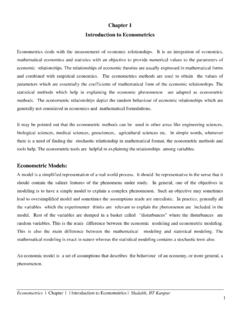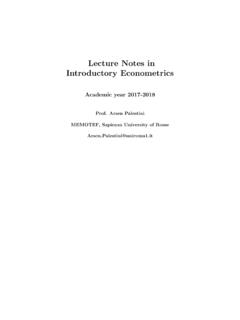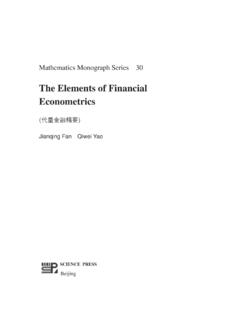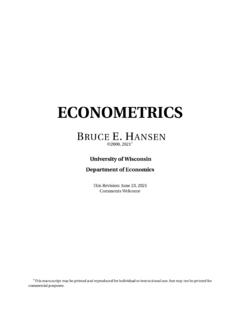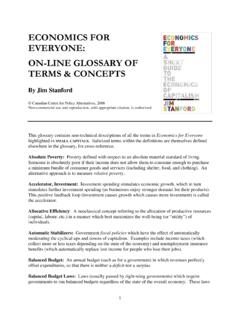Transcription of Econometrics Lecture Notes (OMEGA) - bseu.by
1 Graduate Econometrics Lecture Notes Michael Creel . Version , Copyright (C) Jan 28, 2002 by Michael Creel Contents 1 License, availability and use 10. License .. 10. Obtaining the Notes .. 10. Use .. 10. 2 Economic and econometric models 11. 3 Ordinary Least Squares 13. The classical linear model .. 13. Estimation by least squares .. 14. Estimating the error variance .. 15. Geometric interpretation of least squares estimation .. 15. In X ,Y Space .. 15. In Observation Space .. 16. Dept. of Economics and Economic History, Universitat Aut noma de Barcelona. 1. Projection Matrices .. 16. Influential observations and outliers .. 18. Goodness of fit .. 19. Small sample properties of the least squares estimator.
2 21. Unbiasedness .. 21. Normality .. 22. Efficiency (Gauss-Markov theorem) .. 22. 4 Maximum likelihood estimation 25. The likelihood function .. 25. Consistency of MLE .. 26. The score function .. 28. Asymptotic normality of MLE .. 30. The information matrix equality .. 34. The Cram r-Rao lower bound .. 36. 5 Asymptotic properties of the least squares estimator 40. Consistency .. 40. Asymptotic normality .. 41. Asymptotic efficiency .. 42. 6 Restrictions and hypothesis tests 44. Exact linear restrictions .. 44. Imposition .. 45. Properties of the restricted estimator .. 49. Testing .. 50. t-test .. 50. 2. F test .. 54. Wald-type tests .. 55. Score-type tests (Rao tests, Lagrange multiplier tests).
3 56. Likelihood ratio-type tests .. 59. The asymptotic equivalence of the LR, Wald and score tests .. 60. Interpretation of test statistics .. 65. Confidence intervals .. 65. Bootstrapping .. 66. Testing nonlinear restrictions .. 68. 7 Generalized least squares 73. Effects of nonspherical disturbances on the OLS estimator .. 74. The GLS estimator .. 75. Feasible GLS .. 78. Heteroscedasticity .. 80. OLS with heteroscedastic consistent varcov estimation .. 81. Detection .. 82. Correction .. 85. Autocorrelation .. 88. Causes .. 88. AR(1) .. 89. MA(1) .. 94. Asymptotically valid inferences with autocorrelation of un- known form .. 97. Testing for autocorrelation .. 100. Lagged dependent variables and autocorrelation.
4 102. 3. 8 Stochastic regressors 104. Case 1 .. 105. Case 2 .. 106. Case 3 .. 108. When are the assumptions reasonable? .. 109. 9 Data problems 111. Collinearity .. 111. A brief aside on dummy variables .. 113. Back to collinearity .. 113. Detection of collinearity .. 115. Dealing with collinearity .. 115. Measurement error .. 119. Error of measurement of the dependent variable .. 120. Error of measurement of the regressors .. 121. Missing observations .. 123. Missing observations on the dependent variable .. 123. The sample selection problem .. 126. Missing observations on the regressors .. 127. 10 Functional form and nonnested tests 129. Flexible functional forms .. 130. The translog form.
5 132. FGLS estimation of a translog model .. 138. Testing nonnested hypotheses .. 142. 11 Exogeneity and simultaneity 146. 4. Simultaneous equations .. 146. Exogeneity .. 149. Reduced form .. 152. IV estimation .. 155. Identification by exclusion restrictions .. 160. Necessary conditions .. 161. Sufficient conditions .. 164. 2 SLS .. 172. Testing the overidentifying restrictions .. 176. System methods of estimation .. 182. 3 SLS .. 183. FIML .. 189. 12 Limited dependent variables 192. Choice between two objects: the probit model .. 192. Count data .. 195. Duration data .. 197. The Newton method .. 200. 13 Models for time series data 205. Basic concepts .. 205. ARMA models .. 207.
6 MA(q) processes .. 208. AR(p) processes .. 208. Invertibility of MA(q) process .. 219. 14 Introduction to the second half 222. 5. 15 Notation and review 230. Notation for differentiation of vectors and matrices .. 230. Convergenge modes .. 231. Rates of convergence and asymptotic equality .. 235. 16 Asymptotic properties of extremum estimators 238. Extremum estimators .. 238. Consistency .. 238. Example: Consistency of Least Squares .. 242. Asymptotic Normality .. 246. Example: Binary response models.. 249. Example: Linearization of a nonlinear model .. 255. 17 Numeric optimization methods 259. Search .. 260. Derivative-based methods .. 260. Introduction .. 260. Steepest descent.
7 262. Newton-Raphson .. 262. Simulated Annealing .. 267. 18 Generalized method of moments (GMM) 268. Definition .. 268. Identification .. 271. Consistency .. 271. Asymptotic normality .. 272. Choosing the weighting matrix .. 274. 6. Estimation of the variance-covariance matrix .. 277. Newey-West covariance estimator .. 279. Estimation using conditional moments .. 280. Estimation using dynamic moment conditions .. 285. A specification test .. 286. estimators interpreted as GMM estimators .. 289. OLS with heteroscedasticity of unknown form .. 289. Weighted Least Squares .. 291. 2 SLS .. 292. Nonlinear simultaneous equations .. 294. Maximum likelihood .. 295. : Nonlinear rational expectations.
8 298.. 302. 19 Quasi-ML 303. Consistent Estimation of Variance Components .. 306. 20 Nonlinear least squares (NLS) 309. Introduction and definition .. 309. Identification .. 311. Consistency .. 313. Asymptotic normality .. 313. Example: The Poisson model for count data .. 315. The Gauss-Newton algorithm .. 317. Application: Limited dependent variables and sample selection .. 319. Example: Labor Supply .. 319. 7. 21 Examples: demand for health care 323. The MEPS data .. 323. Infinite mixture models .. 328. Hurdle models .. 333. Finite mixture models .. 338. Comparing models using information criteria .. 344. 22 Nonparametric inference 345. Possible pitfalls of parametric inference: estimation.
9 345. Possible pitfalls of parametric inference: hypothesis testing .. 349. The Fourier functional form .. 350. Sobolev norm .. 355. Compactness .. 356. The estimation space and the estimation subspace .. 356. Denseness .. 357. Uniform convergence .. 359. Identification .. 360. Review of concepts .. 360. Discussion .. 361. Kernel regression estimators .. 362. Estimation of the denominator .. 363. Estimation of the numerator .. 366. Discussion .. 367. Choice of the window width: Cross-validation .. 368. Kernel density estimation .. 368. Semi-nonparametric maximum likelihood .. 369. 8. 23 Simulation-based estimation 375. Motivation .. 375. Example: Multinomial and/or dynamic discrete response models375.
10 Example: Marginalization of latent variables .. 378. Estimation of models specified in terms of stochastic differen- tial equations .. 380. Simulated maximum likelihood (SML) .. 382. Example: multinomial probit .. 383. Properties .. 385. Method of simulated moments (MSM) .. 386. Properties .. 387. Comments .. 388. Efficient method of moments (EMM) .. 389. Optimal weighting matrix .. 392. Asymptotic distribution .. 394. Diagnotic testing .. 395. Application I: estimation of auction models .. 396. Application II: estimation of stochastic differential equations .. 398. Application III: estimation of a multinomial probit panel data model . 400. 24 Thanks 401. 25 The GPL 401. 9. 1 License, availability and use License These Lecture Notes are copyrighted by Michael Creel with the date that appears above.
